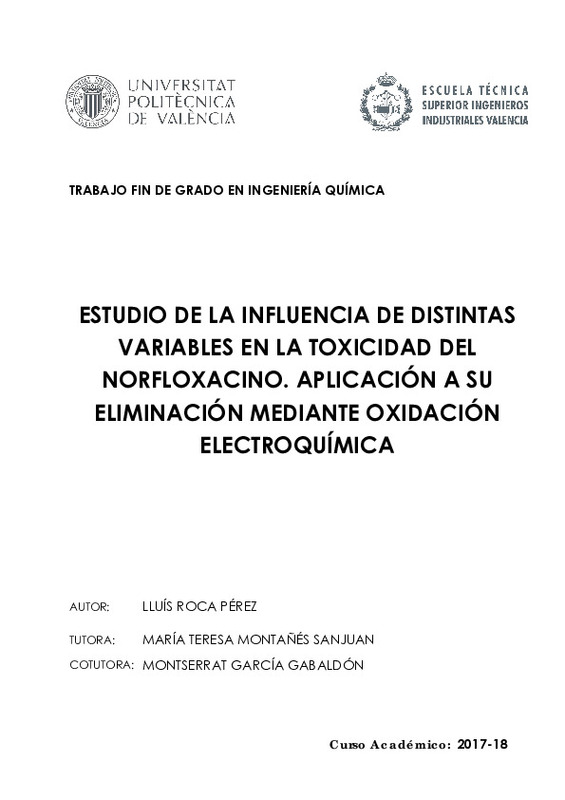JavaScript is disabled for your browser. Some features of this site may not work without it.
Buscar en RiuNet
Listar
Mi cuenta
Estadísticas
Ayuda RiuNet
Admin. UPV
ESTUDIO DE LA INFLUENCIA DE DISTINTAS VARIABLES EN LA TOXICIDAD DEL NORFLOXACINO. APLICACIÓN A SU ELIMINACIÓN MEDIANTE OXIDACIÓN ELECTROQUÍMICA
Mostrar el registro sencillo del ítem
Ficheros en el ítem
| dc.contributor.advisor | García Gabaldón, Montserrat
|
es_ES |
| dc.contributor.advisor | Montañés Sanjuan, María Teresa
|
es_ES |
| dc.contributor.author | Roca Pérez, Lluís
|
es_ES |
| dc.date.accessioned | 2018-10-05T14:01:57Z | |
| dc.date.available | 2018-10-05T14:01:57Z | |
| dc.date.created | 2018-09-14 | |
| dc.date.issued | 2018-10-05 | es_ES |
| dc.identifier.uri | http://hdl.handle.net/10251/109745 | |
| dc.description.abstract | En los últimos años se está poniendo el foco en la detección y eliminación de los llamados contaminantes emergentes de las aguas residuales. Estos, aunque suelen estar presentes en bajas concentraciones, se caracterizan por su baja biodegradabilidad. Este hecho hace que puedan suponer un problema en el medio receptor a largo plazo. Entre estos contaminantes se encuentran, por ejemplo, muchos medicamentos de amplio uso, como es el caso del norfloxacino, un antibiótico usado en infecciones urinarias. La UE tiene catalogadas diferentes técnicas para la determinación de la toxicidad de estos contaminantes, pero aboga por la búsqueda y el desarrollo de nuevas técnicas, haciendo hincapié en el hecho de que no supongan el uso de animales. Por otro lado, continúan desarrollándose nuevas tecnologías, y optimizándose las existentes, para la eliminación de los contaminantes emergentes en las aguas residuales. Una de ellas es la oxidación electroquímica. La aplicación de esta técnica requiere la presencia de un electrolito soporte que aporte conductividad y puede implicar modificaciones del pH de la disolución. En concordancia con lo expuesto, en este trabajo se van a poner en práctica dos métodos para medir la toxicidad del norfloxacino: uno mediante la siembra de semillas de lechuga (¿lactuca sativa¿), y otro mediante el uso del equipo Microtox con bacterias luminiscentes. En concreto, se procederá al estudio de diferentes variables como son la concentración del norfloxacino (el contaminante objeto de estudio), el pH o la concentración de electrolito soporte, y se analizará su efecto sobre la toxicidad de la muestra. Con los resultados obtenidos experimentalmente, y con la ayuda de herramientas estadísticas, se determinarán los umbrales de toxicidad de la muestra objeto de estudio. Por último, en este trabajo, se analizará la toxicidad final de muestras reales de norfloxacino sometidas a un proceso de oxidación electroquímica. | es_ES |
| dc.description.abstract | In recent years, the focus has been on detecting and eliminating of the emerging pollutants of the wastewater. Although they are usually present in low concentrations, they are characterized by their low biodegradability. This fact means that they can be a problem in the long-term if they are received by the environment. For example, among these contaminants are many medicines, such as norfloxacine, an antibiotic used in urinary tract infections. The EU has cataloged different techniques for the determination of the toxicity of these pollutants, but advocates the search and development of new techniques, emphasizing the fact that they do not involve the use of animals. On the other hand, new technologies continue to be developed, and existing ones are being optimized for the elimination of emerging pollutants in wastewater. One of them is electrochemical oxidation. The application of this technique requires the presence of a supporting electrolyte that provides conductivity and may involve changes in the pH of the solution. In agreement with the above, this work will put into practice two methods to measure the toxicity of norfloxacine: one by sowing lettuce seeds ("lactuca sativa"), and another by using the Microtox equipment with luminescent bacteria. In particular, we will proceed to the study of different variables such as the concentration of norfloxacine (the pollutant under study), the pH or the concentration of electrolyte support, and its effect on the toxicity of the sample will be analyzed. With the results obtained experimentally, and the toxicity thresholds of the sample under study will be determined with the help of statistical tools. Finally, in this work, the final toxicity of real samples of norfloxacine subjected to an electrochemical oxidation process will be analyzed. | es_ES |
| dc.language | Español | es_ES |
| dc.publisher | Universitat Politècnica de València | es_ES |
| dc.rights | Reconocimiento - Sin obra derivada (by-nd) | es_ES |
| dc.subject | norfloxacino | es_ES |
| dc.subject | contaminante emergente | es_ES |
| dc.subject | ¿lactuca sativa¿ | es_ES |
| dc.subject | toxicidad | es_ES |
| dc.subject | oxidación electroquímica | es_ES |
| dc.subject | Toxicity | es_ES |
| dc.subject | norfloxacine | es_ES |
| dc.subject | electrochemical oxidation | es_ES |
| dc.subject | emerging contaminants | es_ES |
| dc.subject | "lactuca sativa" | es_ES |
| dc.subject | Microtox | es_ES |
| dc.subject.classification | INGENIERIA QUIMICA | es_ES |
| dc.subject.other | Grado en Ingeniería Química-Grau en Enginyeria Química | es_ES |
| dc.title | ESTUDIO DE LA INFLUENCIA DE DISTINTAS VARIABLES EN LA TOXICIDAD DEL NORFLOXACINO. APLICACIÓN A SU ELIMINACIÓN MEDIANTE OXIDACIÓN ELECTROQUÍMICA | es_ES |
| dc.type | Proyecto/Trabajo fin de carrera/grado | es_ES |
| dc.rights.accessRights | Abierto | es_ES |
| dc.contributor.affiliation | Universitat Politècnica de València. Departamento de Ingeniería Química y Nuclear - Departament d'Enginyeria Química i Nuclear | es_ES |
| dc.contributor.affiliation | Universitat Politècnica de València. Escuela Técnica Superior de Ingenieros Industriales - Escola Tècnica Superior d'Enginyers Industrials | es_ES |
| dc.description.bibliographicCitation | Roca Pérez, L. (2018). ESTUDIO DE LA INFLUENCIA DE DISTINTAS VARIABLES EN LA TOXICIDAD DEL NORFLOXACINO. APLICACIÓN A SU ELIMINACIÓN MEDIANTE OXIDACIÓN ELECTROQUÍMICA. http://hdl.handle.net/10251/109745 | es_ES |
| dc.description.accrualMethod | TFGM | es_ES |
| dc.relation.pasarela | TFGM\86005 | es_ES |
Este ítem aparece en la(s) siguiente(s) colección(ones)
-
ETSII - Trabajos académicos [10404]
Escuela Técnica Superior de Ingenieros Industriales






